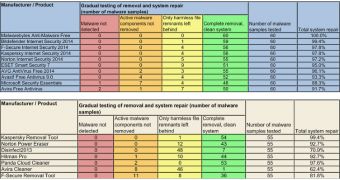In a 10-month long test, AV-TEST has tried to find out if antivirus products are capable of cleaning and repairing a Windows system in the aftermath of a malware infection.
The results concluded that the current security solutions on the market can clean the malicious software from a system and restore it to its previous pristine state.
Between September 2013 and June 2014, AV-TEST, an independent organization that evaluates the performance of security software, put through this challenge a number of 17 products (10 antivirus solutions and 7 special cleaning tools).
Part of the test were free antivirus solutions from Avira, Avast, Malwarebytes, AVG, Microsoft and paid ones from Bitdefender, ESET, F-Secure, Kaspersky and Symantec, along with cleaning tools such as Avira Cleaner, Hitman Pro, Disinfect2013 and F-Secure Removal Tool, Kaspersky Virus Removal Tool, Panda Cloud Cleaner, and Norton Power Eraser.
A total of 60 tests were conducted and Malwarebytes Anti-Malware Free managed to achieve the perfect score, detecting and removing the threats affecting the computer system, as well as eliminating any trace of the malware.
Runner up was Bitdefender’s solution, which managed to do this in 59 of the challenges. Next were products from F-Secure and Kasperky, achieving success in 56 cases, although they left behind some harmless registry entries.
Kaspersky Removal Tool also rose to the challenge and successfully cleaned the system of all errors, except one, harmless, nonetheless preventing it from achieving a perfect score.
“The test results disproved a statement frequently posted in forums, that all you can do is delete your Windows system if it becomes infected with malware,” concludes the report.
AV-TEST’s evaluation included multiple known malware families, which were tested repeatedly because of the changes they undergo in time.
The researchers focused on several aspects, such as the detection of the malicious file, complete removal of the active components, presence of harmless remnants, restoring the system to its original state after the cleaning procedure, and perfect removal and restoration of all the necessary changes.
As far as the testing of antivirus is concerned, researchers wanted to simulate a scenario where the user added the security solution after the system got infected in order to determine if the products detected the threats after a certain period of time.
As such, a two-part test was devised. Antivirus was first installed on an already infected system and then added on a clean computer, disabled and then re-activated after malware was loaded; 30 malware samples were used in each step.

 14 DAY TRIAL //
14 DAY TRIAL //